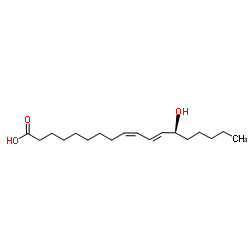Circadian stage-dependent inhibition of human breast cancer metabolism and growth by the nocturnal melatonin signal: consequences of its disruption by light at night in rats and women.
David E Blask, Robert T Dauchy, George C Brainard, John P Hanifin
Index: Integr. Cancer Ther. 8(4) , 347-53, (2009)
Full Text: HTML
Abstract
The circadian production of melatonin by the pineal gland during the night provides an inhibitory signal to tissue-isolated steroid receptor SR+ and - MCF-7 human breast cancer xenografts in female nude rats. A pivotal mechanism for melatonin's anticancer effects in vivo involves a melatonin receptor-mediated inhibition of linoleic acid (LA) uptake and its metabolism to mitogenically active 13-hydroxyoctadecadienoic acid (13-HODE). Exposure of (SR-) xenograft-bearing rats to increasing intensities of polychromatic white light at night suppresses melatonin while increasing tumor growth rates, DNA content, [3H]thymidine incorporation into DNA, LA uptake, 13-HODE formation, cAMP levels and ERK1/2 activation a dose-dependent manner. Similar effects occur in SR- human breast cancer xenografts perfused in situ with melatonin-depleted blood from healthy female subjects after their exposure to a single bright intensity (2800 lux) of polychromatic light at night. Additionally, SR- human breast cancer xenografts exhibit robust circadian rhythms of LA uptake, 13-HODE formation and proliferative activity. Exposure of xenograft-bearing rats to dim light at night results in the complete elimination of these rhythms which culminates in unfettered, high rates of tumor metabolism and growth. The organization of tumor metabolism and growth within circadian time structure by the oncostatic melatonin signal helps create a balance between the cancer and its host that is disrupted by host exposure to light at night. This biological mechanism may partially explain the higher risk of breast and other cancers in women working rotating night shifts and possibly others who also experience prolonged exposure to light at night.
Related Compounds
| Structure | Name/CAS No. | Molecular Formula | Articles |
|---|---|---|---|
 |
13S-hydroxyoctadecadienoic acid
CAS:29623-28-7 |
C18H32O3 |
|
Light exposure at night disrupts host/cancer circadian regul...
2014-01-01 [PLoS ONE 9(8) , e102776, (2014)] |
|
Doxorubicin resistance in breast cancer is driven by light a...
2015-08-01 [J. Pineal Res. 59 , 60-9, (2015)] |
|
Implications of chemokines, chemokine receptors, and inflamm...
2014-04-01 [J. Leukoc. Biol. 95(4) , 575-85, (2014)] |
|
Effect of ω-3 and ω-9 fatty acid rich oils on lipoxygenases ...
2010-01-01 [Lipids Health Dis. 9 , 112, (2010)] |
|
Ligand-induced formation of transient dimers of mammalian 12...
2012-03-01 [Proteins 80(3) , 703-12, (2012)] |